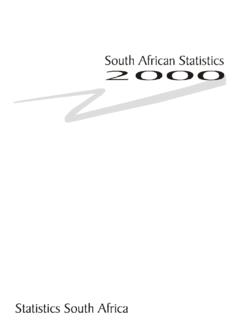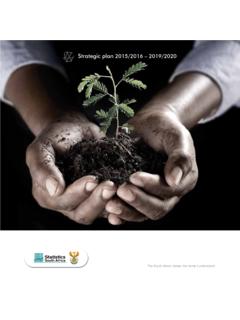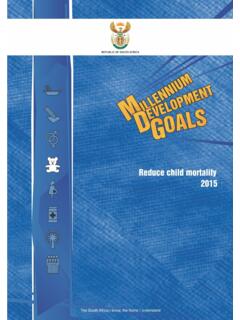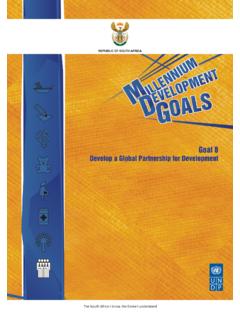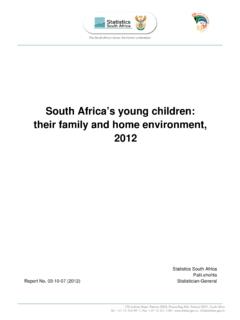Transcription of Mid-year population estimates - Statistics South Africa
1 T +27 12 310 8911 F +27 12 310 8500 Private Bag X44, Pretoria, 0001, South Africa ISIbalo House, Koch Street, Salvokop, Pretoria, 0002 STATISTICAL RELEASE P0302 Mid-year population estimates2018 Embargoed until: 23 July 2018 11:00 ENQUIRIES: FORTHCOMING ISSUE: EXPECTED RELEASE DATE: User Information Services 2019 31 July 2019 Tel: (012) 310 8600 / 4892 / 8390 Statistics South Africa P0302 Mid-year population estimates , 2018 ii Contents Summary .. 1 1. Introduction .. 3 2. Demographic and other assumptions .. 3 3. Demographic and other indicators .. 5 4. National population estimates .. 8 5. Provincial population estimates .. 11 Demographic assumptions .. 11 Migration patterns .. 14 Provincial distributions.
2 16 References .. 19 Appendices .. 21 List of tables Table 1: Mid-year population estimates for South Africa by population group and sex, 2018 .. 2 Table 2: Assumptions of expectation of life at birth without HIV/AIDS and total fertility rate, 2002 2018 .. 4 Table 3: International net-migration assumptions for the period 1985 2021 .. 4 Table 4: Births and deaths for the period 2002 2018 .. 7 HIV prevalence .. 7 Table 5: Mid-year population estimates by population group and sex, 2018 .. 9 Table 6: Mid-year population estimates by population group, age and sex, 2018 .. 10 Table 7: Estimated provincial migration streams 2006 2011 .. 14 Table 8: Estimated provincial migration streams 2011 2016 .. 15 Table 9: Estimated provincial migration streams 2016 2021 .. 15 Table 10: Percentage distribution of the projected provincial share of the total population , 2002 2018 .. 16 Table 11 (a): Provincial Mid-year population estimates by age and sex, 2018.
3 17 Table 11 (b): Provincial Mid-year population estimates by age and sex, 2018 (concluded) .. 18 List of figures Figure 1: Mid-year population estimates for South Africa by province, 2018 .. 2 Figure 2: Crude birth rate, crude death rate, and rate of natural increase over time, 2002 2018 .. 5 Figure 3: Life expectancy by sex over time, 2002 2018 .. 6 Figure 4: IMR, U5MR and CDR over time, 2002 2018 .. 6 Figure 5: HIV prevalence by selected age groups, 2002 2018 .. 8 Figure 6: HIV population over time, 2002 2018 .. 8 Figure 7: population growth rates by selected age groups over time, 2002 2018 .. 9 Statistics South Africa P0302 Mid-year population estimates , 2018 iii Figure 8: Provincial average total fertility rate over time, 2001 2021 .. 11 Figure 9: Provincial average total fertility rate, 2016 2021 .. 12 Figure 10: Provincial average life expectancy at birth (males).
4 12 Figure 11: Provincial average life expectancy at birth (females) .. 13 Figure 12: population under 15 years of age .. 19 Figure 13: Proportion of elderly aged 60+ .. 19 Statistics South Africa P0302 Mid-year population estimates , 2018 1 Summary This release uses the cohort-component methodology to estimate the 2018 Mid-year population of South Africa . The estimates cover all the residents of South Africa at the 2018 Mid-year , and are based on the latest available information. estimates may change as new data become available. with the new estimate comes an entire series of revised estimates for the period 2002 2018. For 2018, Statistics South Africa (Stats SA) estimates the Mid-year population at 57,73 million. Approximately 51% (approximately 29,5 million) of the population is female. Gauteng comprises the largest share of the South African population , with approximately 14,7 million people (25,4%) living in this province.
5 KwaZulu-Natal is the province with the second largest population , with 11,4 million people (19,7%) living in this province. with a population of approximately 1,23 million people (2,1%), Northern Cape remains the province with the smallest share of the South African population . About 29,5% of the population is aged younger than 15 years and approximately 8,5% (4,89 million) is 60 years or older. Similar proportions of those younger than 15 years live in Gauteng (21,1%) and KwaZulu-Natal (21,0%). Of the elderly aged 60 years and older, the highest percentage 24,0% (1,18 million) reside in Gauteng. The proportion of elderly persons aged 60 and older is increasing over time. Migration is an important demographic process in as it shapes the age structure and distribution of the provincial population . For the period 2016 2021, Gauteng and Western Cape are estimated to experience the largest inflow of migrants of approximately, 1 048 440 and 311 004 respectively (see migration stream Tables 7, 8 and 9 for net migration).
6 Life expectancy at birth for 2018 is estimated at 61,1 years for males and 67,3 years for females. The infant mortality rate for 2018 is estimated at 36,4 per 1 000 live births. The estimated overall HIV prevalence rate is approximately 13,1% among the South African population . The total number of people living with HIV is estimated at approximately 7,52 million in 2018. For adults aged 15 49 years, an estimated 19,0% of the population is HIV positive. Statistics South Africa P0302 Mid-year population estimates , 2018 2 Table 1: Mid-year population estimates for South Africa by population group and sex, 2018 population group Male Female Total Number % distribution of males Number % distribution of females Number % distribution of total Black African 22 786 200 80,9 23 896 700 80,9 46 682 900 80,9 Coloured 2 459 500 8,7 2 614 800 8,9 5 074 300 8,8 Indian/Asian 740 200 2,6 708 100 2,4 1 448 300 2,5 White 2 194 200 7,8 2 325 900 7,9 4 520 100 7,8 Total 28 180 100 100,0 29 545 500 100,0 57 725 600 100,0 Figure 1.
7 Mid-year population estimates for South Africa by province, 2018 Risenga Maluleke Statistician-General 1471700011384700662110065227005797300452 390039790002954300122560002 000 0004 000 0006 000 0008 000 00010 000 00012 000 00014 000 000 GautengKwaZulu-NatalWestern CapeEastern CapeLimpopoMpumalangaNorth WestFree StateNorthern CapeSTATISTICS South Africa P0302 Mid-year population estimates , 2018 3 1. Introduction In a projection, the size and composition of the future population of an entity such as South Africa is estimated. The Mid-year population estimates produced by Statistics South Africa (Stats SA) uses the cohort-component method for population estimation. In the cohort-component method, a base population is estimated that is consistent with known demographic characteristics of the country.
8 The cohort base population is projected into the future according to the projected components of change. Selected levels of fertility, mortality and migration are used as input to the cohort-component method. For the 2018 Mid-year estimates , the cohort-component method is utilised within the Spectrum Policy Modelling system. Spectrum is a Windows-based system of integrated policy models (version ). The DemProj module within Spectrum is used to develop the demographic projection, whilst the AIDS Impact Model (AIM) is used to incorporate the impacts of HIV and AIDS on fertility and mortality, and ultimately the population estimates . Stats SA subscribes to the specifications of the Special Data Dissemination Standards (SDDS) of the International Monetary Fund (IMF). The Mid-year estimates are an estimate of the population as at 01 July in a given year. The estimates of stock such as population size, number infected with HIV etc.
9 Pertain to the middle of the year 01 July, whilst the estimates of flow births, deaths, Total Fertility Rates (TFRs), Infant Mortality Rates (IMRs) etc. are for a 12-month period 01 July 2018 to 30th June 2019. A stock variable is measured at one specific time, and represents a quantity at each moment in time the number of population at a certain moment whilst an estimate of flow is typically measured over a certain interval of time. The Mid-year population estimates are published annually. 2. Demographic and other assumptions A cohort-component projection requires a base population distributed by age and sex. Levels of mortality, fertility and migration are estimated for the base year and projected for future years. The cohort base population is projected into the future according to the projected components of population change. The DemProj module of Spectrum is used to produce a single-year projection, thus the TFR and the life expectancy at birth must be provided in the same format single years.
10 The time series of TFR estimates for all population groups in South Africa are derived following a detailed review of TFR estimates (1985 2018), published and unpublished, from various authors, methods and data sources. The finalised TFR assumptions can be found in Table 2 (page 4). The estimates of fertility show a fluctuation over the period 2002 2018, giving rise to a population structure indicative of that of Census 2011 population structure. Between the period 2009 and 2018, fertility has declined from an average of 2,66 children per woman to 2,4 children in 2018. Other inputs required in DemProj include the age-specific fertility rate (ASFR) trend, sex ratios at birth and net international migration. In estimating South Africa s population , international migration is provided as an input into the model (see Table 3, page 4). Net international migration estimates are derived using not only Census 2011 migration data, but also migration numbers and proportions from various other authors, methods and data sources such as the International Organisation for Migration (IOM), Organisation for Economic Co-operation and Development (OECD) which form part of the UN network as well as census data from National Statistics offices (NSO) of various countries.

